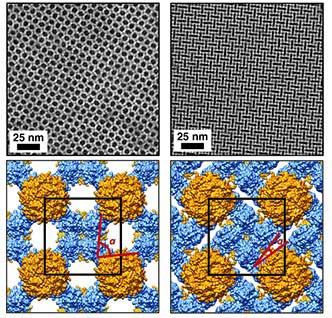| Posted: Sep 02, 2016 |
Breathable and stretchable protein wafers
(Nanowerk News) Scientists constructed defect-free sheets of material with pores that “breathe”—open and close simultaneously without falling apart. The material also displays counterintuitive mechanical behavior. Unlike materials such as pizza dough that get thinner when stretched, these sheets expand or contract equally in both directions when stretched or compressed. This unusual property makes them potentially attractive components for constructing highly resilient, chemically tunable, lightweight materials (Nature, "Self-assembly of coherently dynamic, auxetic, two-dimensional protein crystals").
|
 |
| High magnification electron microscopy views (top) of open and closed conformations of flat, two-dimensional sheets of porous square protein crystals linked at the corners by precisely positioned disulfide bonds. The pores go from an open state (right) to a closed state (left) as the flexible crystal is stretched. This process is reversible allowing the crystals to “breathe.” In the bottom panels, the top and bottom halves of the protein lattice are colored orange and blue, respectively, to highlight the relative molecular orientations in the open and closed states. (Image: Akif Tezcan, University of California, San Diego)
|
|
These thin films represent the first materials designed at the molecular level that display this level of auxetic behavior, or becoming thicker perpendicular to the applied force rather than narrower as would be expected normally. Auxetic materials display a superior capability for absorbing sound and vibration, resisting shear, indentation, and fracture, and the potential for active control and tuning of pore structure. These features make them attractive as filters, sensors, and lightweight yet highly resilient composite and laminate materials for fabricating tougher packaging, transportable electronics such as cell phones, protective armor, and more energy-efficient vehicles and planes.
|
|
Two-dimensional (2D) crystalline materials possess unique structural, mechanical, and electronic properties that make them highly attractive in many applications. Although there have been advances in preparing 2D materials that consist of one or a few atomic or molecular layers, bottom-up assembly of 2D crystalline materials and the design of dynamic 2D lattices that can undergo large-scale motions without loss of crystallinity remain major challenges and active areas of development.
|
|
In particular, proteins are attractive building blocks for 2D materials because of their structural and chemical diversity, and inherent functions. While progress has been made in the design and synthesis of 2D protein-based assemblies, the integration of dynamic or adaptive behavior that would greatly broaden the functional scope has yet to be explored.
|
|
Scientists at the University of California-San Diego have now used a simple chemical-bonding and readily accessible molecular design strategy to control protein self-assembly and synthesize unsupported, 2D protein lattices with precise spatial arrangements and patterns. They modified square-shaped protein building blocks to incorporate sulfur-containing (cysteine) amino acids at each corner to enable disulfide-directed self-assembly.
|
|
Assembly of the porous 2D protein lattices was triggered by adding a chemical that extracted a hydrogen atom from each sulfur causing the sulfur groups to bond to each other. They chose this chemical bonding approach because disulfide bonds are strong but reversible to ensure self-healing. In addition, these bonds are short yet sufficiently flexible to simultaneously afford crystallinity and adaptiveness, chemically tunable to exert external control over self-assembly and enable stimuli-responsiveness, and easily designed and engineered.
|
|
While the reversibility of disulfide bonds ensures self-healing and formation of pristine 2D crystal lattices, their flexibility allows individual protein components to rotate causing the lattice pores to open and close in coherence. Quite unexpectedly, rotary motion of protein components leads to the contraction or expansion of the lattices equally in both dimensions.
|
|
Such auxetic materials are expected to have highly desired mechanical properties such as high energy absorption, fracture resistance, and resiliency.
|

